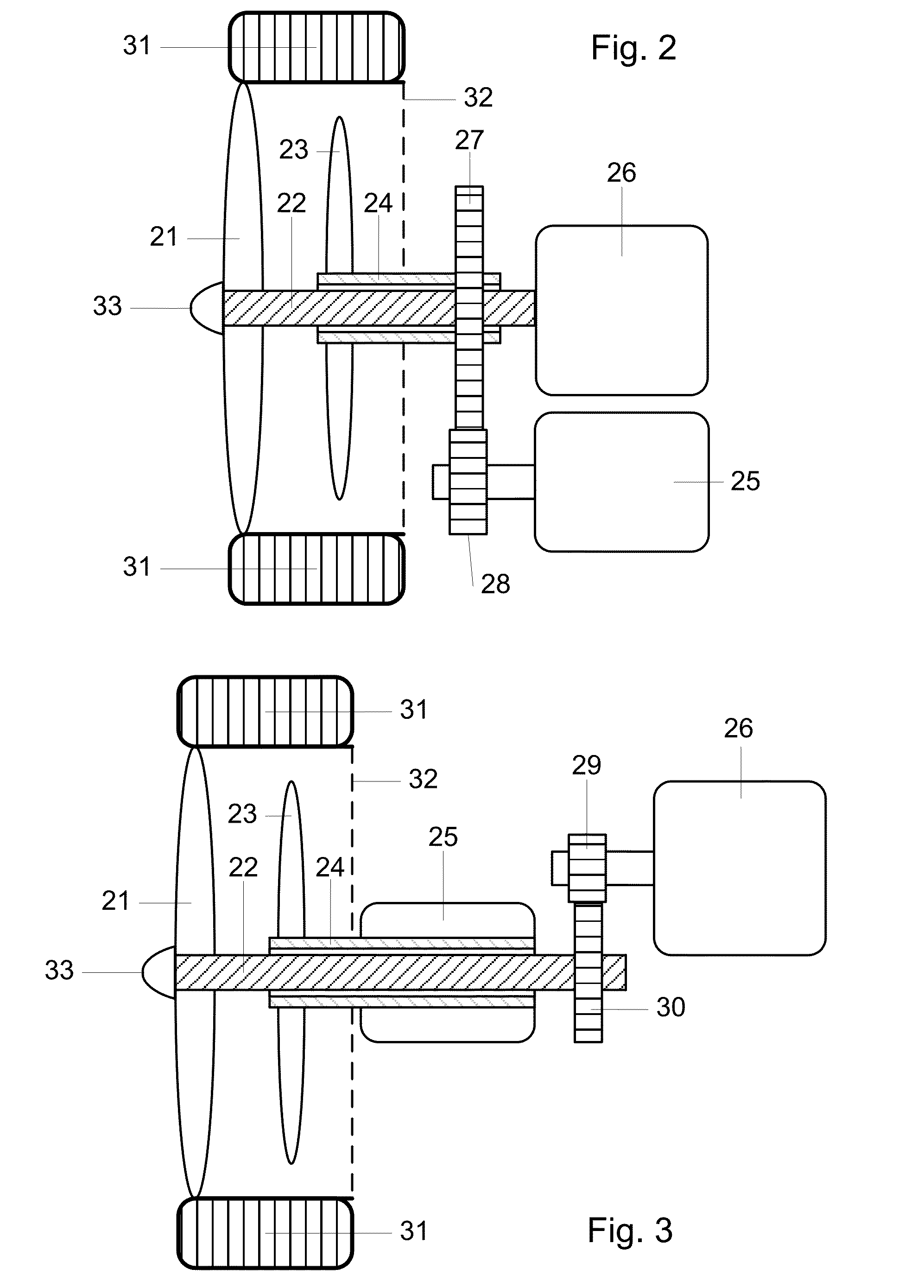Wind Energy Recovery in the Wheels of Vehicles
a technology of wind energy recovery and vehicle wheels, which is applied in the direction of liquid fuel engines, vessel construction, marine propulsion, etc., can solve the problems of inability to meet the needs of transportation,
- Summary
- Abstract
- Description
- Claims
- Application Information
AI Technical Summary
Benefits of technology
Problems solved by technology
Method used
Image
Examples
first embodiment
Advantages—FIGS. 1A, 1B, 1C
[0036]From the descriptions of configuration and operation, the following general advantages of the first embodiment are evident:
[0037](a) The absence of gears, also known as direct drive, reduces mechanical losses typically associated with gears.
[0038](b) The load on motor 26 is reduced without gearing, allowing motor 26 to output more rotational energy per given unit of input energy thereby increasing efficiency of the motoring section. Increased efficiency of the motoring section improves the production of slipstream, resulting in the improved efficiency of slipstream energy recovery.
[0039](c) The absence of gears reduces the overall inertia of the generating section, thereby improving the efficiency of the generating section.
[0040](d) The use of concentric rotatable shafts reduces the lengths and weights of the shafts, as compared to non-concentric shafts, thus enabling a more compact embodiment and a more attractive commercial implementation.
[0041](e)...
embodiment 2
Alternative Embodiment 2
Advantages—FIG. 2
[0055]The advantage of this embodiment over the first embodiment is the flexibility in the configuration enabled by the of use gears thereby allowing for generator 25 to be situated unaligned from generating shaft 24. Generator 25 can now be more easily disassembled and even removed entirely for maintenance and repair. Additionally, for the purposes of product development, those skilled in the art will be able to more conveniently experiment with different generators by simply removing generator 25 and its generating pinion 28. Commercial-off-the-shelf generators can be used instead of custom made generators that would have to fit the specific diameter of generating shaft 24, as in the case of the embodiment of FIG. 1A.
Alternative Embodiment 3
Configuration—FIG. 3
[0056]The embodiment of FIG. 3 illustrates an alternative to FIG. 1A by the possible use of gearing with motor 26. A motoring gear 30 is mounted towards the rear of motoring shaft 22....
embodiment 3
Alternative Embodiment 3
Advantages—FIG. 3
[0058]The advantage of this embodiment over the first embodiment is the flexibility in the configuration enabled by the use of gears thereby allowing for motor 26 to be situated unaligned from motoring shaft 22. Motor 26 can now be more easily disassembled and even removed entirely for maintenance and repair. Additionally, for the purposes of product development, those skilled in the art will be able to more conveniently experiment with different motors by simply removing motor 26 and its motoring pinion 29. Commercial-off-the-shelf motors can be used instead of custom made motors that would have to fit the specific diameter of motoring shaft 22, as in the case of the first embodiment of FIG. 1A.
Alternative Embodiment 4
Configuration—FIG. 4
[0059]The embodiment of FIG. 4 illustrates an alternative to FIG. 1A by having both motor 26 and generator 25 geared as previously described individually in alternative embodiments 2 and 3.
Alternative Embodi...
PUM
 Login to View More
Login to View More Abstract
Description
Claims
Application Information
 Login to View More
Login to View More - R&D
- Intellectual Property
- Life Sciences
- Materials
- Tech Scout
- Unparalleled Data Quality
- Higher Quality Content
- 60% Fewer Hallucinations
Browse by: Latest US Patents, China's latest patents, Technical Efficacy Thesaurus, Application Domain, Technology Topic, Popular Technical Reports.
© 2025 PatSnap. All rights reserved.Legal|Privacy policy|Modern Slavery Act Transparency Statement|Sitemap|About US| Contact US: help@patsnap.com



